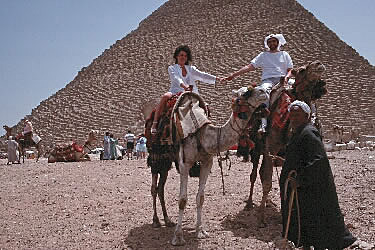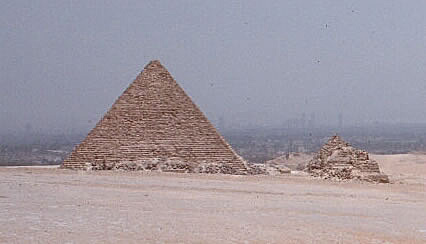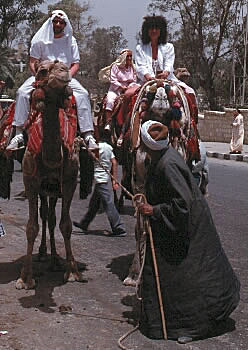 |
| OK, let's get something straight up front! Who's never heard of the Great Pyramid of Khufu (Cheops)? Who's never seen a picture of the Great Pyramid of Khufu? If you're old enough to read and hold a book then, I'm sure, at one time or another you've seen a picture of this pyramid which stands at Giza. It is the oldest and only survivor of the Seven Ancient Wonders of the World. The Great Pyramid of Khufu, along with the smaller pyramids of Khafre (Chephren) and Menkaure (Micerinus) and the Great Sphinx, are located on the Giza Plateau. Once a part of the necropolis of ancient Memphis, the pyramids at Giza are today a part of Greater Cairo. Situated on the top of the Giza Plateau they are, of course, a dominant feature of the landscape when you are anywhere near them. | |||||||||
| Our trip to the top of the Giza Plateau and the base of the Great Pyramid of Khufu would begin in a smelly camel yard at the base of the plateau. Take my word for it. Standing next to a camel isn't a bad experience at all, but standing in an area where there are many camels the smells can be overpowering. We couldn't wait to get on the camel and out of that smelly camel yard. For those that have never ridden a camel before it's an interesting experience and definitely not like riding a horse. There are several distinct differences. First you're higher off the ground. Second the camel's gait feels somewhat different than that of a horse. Third, and by far the most different, is how you get on and off. Unlike a horse, you mount a camel while it is sitting on the ground. Once seated the animal stands on its back legs and then stands on its front legs. Getting up wasn't bad, but the coming down was a bit of a shock. Arriving at the base of Cheops we took a couple of pictures and when it was time to get off the handler motioned to the camel to lay down. Well, the surprise comes when the camel buckles his front legs and begins to lay down. I wasn't expecting such a quick collapse of those front legs and it almost threw me over the camel's head. It was, to say the least, an interesting experience and I'd definitely do it again if I ever find myself at Giza. |
|
||||||||
 Anne holding on for dear life! |
 Anne and I in front of the Great Pyramid of Khufu |
||||||||
|
The Great Pyramid of Khufu, commonly referred to as "Cheops," was built around 2560 B.C. by the pharaoh Khufu of the 4th Dynasty. There are many theories as to how it was built and how long a period it took to build. The History Channel has excellent documentaries about Egypt that we suggest you watch when they are on. It's absolutely fascinating to learn about the history and even more fascinating to stand beside these magnificent structures and be able to touch them. |
|||||||||
|
Cheops, at 481 feet high, was the tallest structure on Earth for over 40 centuries; it was only in the nineteenth century that it was eclipsed. The pyramid today stands only about 450 feet high having lost about 30 feet of its original height over the centuries. Each side of Cheops is oriented to the cardinal points of the compass, north, south, east and west, and the sloping angle measures 51 degrees and 51 minutes. Each side measures 751 feet and has an amazing maximum error in length of less than 0.1%. Over two million blocks of stone were used in the construction with each weighing over two tons. You can enter the pyramid and, following original shafts within the structure, make your way to the burial chamber located in the heart of the pyramid. The only remaining item inside the burial chamber is Khufu's sarcophagus. The sarcophagus is made of red granite and is, like the pyramid itself, oriented to the cardinal points of the compass. It's size is only one centimeter smaller than the doorway leading to the chamber which leads scholars to believe that the sarcophagus was introduced during the building of the pyramid and not after its completion. A word of caution concerning your entering the pyramid. No, I wouldn't worry to much about it falling down on you. It's managed to stand for centuries and the chances are it will remain standing for the short period of time you're in it. But, the climb can be strenuous given the extreme heat, cramped space and incline. It is, however, well worth the experience if you are physically fit for such an activity. Anne and I visited Egypt in the early part of May before the really hot summer months which helped. Mind you, it was still hot, sometimes as high as 120 degrees in the Sun, but better than the hotter summer months. Also, when your arrive at the burial chamber be prepared for a not so pleasant odor. I'll leave it to your imagination to determine what you think the smell is. Anne and I definitely have our own ideas. Unfortunately my pictures of Cheops and the other pyramids of the Giza Plateau are not great. That's the unfortunate thing about being on escorted tours. You rarely have the time to study the location and figure out the best time and angle to take photographs. You are there when you get there and you have to leave when they are ready to leave. Even so, to Anne and I, the pictures represent some wonderful memories. Enjoy these few pictures that we took. |
|||||||||
 Cheops (Khufu's), Chephren (Khafre's) and Micerinus (Menkaure's) pyramids |
The photo (left) shows the Giza Plateau and the three large pyramids located there. In the center is Chephren (Khafre's pyramid) which still has some of the casing stones visible at its top. To the left is Cheops (Khufu's pyramid) and to the right the smaller Micerinus (Menkaure's pyramid). Each pyramid also had a funerary temple located nearby in the valley. Cheops funerary temple is almost completely destroyed while Khafre's is relatively intact. Smaller pyramids, the Queen's pyramids, can be found nearby Menkaure's and Khufu's pyramids. | ||||||||
|
Menkaure is believed to be the son of Khafre and grandson of Khufu. For each pyramid there was a mortuary temple and a valley temple that were linked by walled and roofed causeways. The Sphinx is part of Khafre's funerary complex. Alongside both Khufu's and Khafre's pyramids large boat-shaped pits were found with buried boats, believed to have carried the pharaoh on his last journey on Earth and to aide the pharaoh on his journey to the afterlife. Khufu's boat pits were only discovered in 1954 and, today, adjacent to Khufu's pyramid, there is a museum housing the Pharaoh's Sun Boat.
|
 Pharaoh Menkaure's Pyramid (Micerinus) with Cairo in the background |
||||||||
| Continue to the next page to see pictures of the Great Sphinx at Giza. | |||||||||

